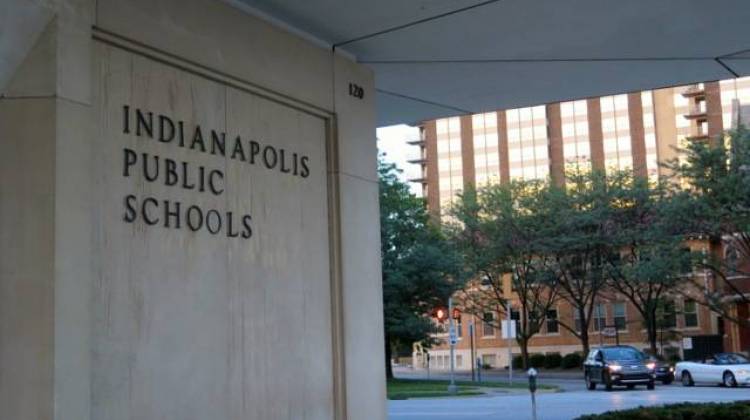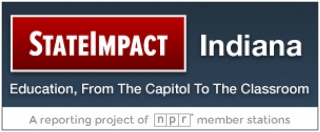
Indianapolis Public Schools is still projected to see steep losses under the Senate's proposed budget, but it would not be as harsh as under the House's plan.
Hayleigh Colombo/ChalkbeatThe Indiana Senate’s proposed budget would boost funding for education overall, much like the draft from the House, but it attempts to do so while ensuring urban schools won’t be hit as hard because of declining enrollment, lawmakers said.
In the draft released today, Indianapolis Public Schools, slated to lose 6 percent in total state tuition aid by 2017 under the House’s version, would lose 4.2 percent in total aid in the Senate’s plan. That change is largely because of a shift in how the Senate proposes the state allocate extra money to students from low-income families who might start school academically behind their peers.
Sen. Ryan Mishler, R-Bremen, said students would now qualify for the extra money, determined by a poverty calculation known as the complexity index, if they also qualify for welfare, food stamps or are in foster care. Under the House’s plan, students qualify if they come from families poor enough to receive free lunch.
Mishler said his method would be phased in over five years and give a little more money to schools than the House’s would. Urban schools seeing declining enrollment, like IPS, would still lose money, but not quite as much, and it would be spread over a longer period of time so they can better adjust.
Wealthier schools, such as those in Zionsville and Carmel, still gain funding because of their growing populations. Zionsville would see a 9.2 percent increase in total state aid, and Carmel would receive 9.5 percent.
“If you take the number that the House spent for the complexity index in the first year, I think we raise it about $30 million, and in the second year, about $50 million,” Mishler said. “So it’s fairly close in the total dollar amount, it just changes the way we distribute it a little bit.”
Wealthy schools in typically suburban areas have argued they deserve more funding to support their students because they often produce the state’s best test scores. But poorer schools, which tend to be in heavily urban or rural areas, say they need the extra funding to educate children from poor families who might start out behind.
Like in the House’s plan, all Marion County schools besides IPS see increases in total state aid by 2017, with Beech Grove gaining the most at 9.1 percent and Franklin Township coming in second at 7 percent.
Chairman of the Senate Appropriations Committee Luke Kenley, R-Noblesville, said he, like his fellow Republican legislators, focused the budget on education, proposing a $31.5 billion two-year budget with a $466 million increase in K-12 funding over that time. That means a 2.3 percent increase in 2016 and a 2.3 percent increase in 2017.
“Speaker Bosma ran his campaign on this being a year of education, the governor said this is the year of education,” Kenley said. “We kind of are drilling back down on that primarily, and most of the money we are spending is going in those areas.”
The Senate’s budget also increases the basic tuition amount for each student, or the “foundation level,” to $4,943 in 2016 and $5,052 in 2017 — slightly less than what the House proposed. The House would up K-12 funding by $469 million from 2015 to 2017, with a basic aid amount of $4,984 in 2016 and $5,105 in 2017.
House budget leader Rep. Tim Brown, R-Crawfordsville, said both budgets are very close in dollar amounts, and both houses have goals to serve both wealthy and poor schools, though they go about it in slightly different ways through the complexity index.
“I think we both have the same philosophical goals that we want to substantially increase the foundation,” Brown said. “And they do that, as well as our budget does that.”
The Senate draft also differs from the House and governor’s plan in that it includes no additional funding for charter schools. Kenley said it was too soon to make decisions about such a large sum of money. Charter school laws are too lax, and there’s no way to guarantee a school, for example, couldn’t collect that additional aid and then close the next year and take it for profit, he said.
“I think a summer study committee … is a way to get all this stuff straightened out and come back with a much better product,” Kenley said. “Because it’s going to cost money, and it could be big dollars.”
For the state’s ISTEP test, the Senate set aside $71.6 million over two years — higher than in the past, but less than what has been projected recently for proposals by state Superintendent Glenda Ritz and the Indiana State Board of Education. Here’s how it breaks down:
- $16.7 million per year for English and Math ISTEP tests in grades 3-10 (not ninth), social studies in grades five and seven, and science in grades 4, 6 and 10.
- $3.35 million per year for the third-grade reading test, IREAD.
- $3.75 million per year for the high school end of course exams in English 10 and Algebra 1.
- An additional $12 million per year for tests districts can choose to use to measure student progress and practice ISTEP skills.
Kenley said the costs come straight from British-based testing company Pearson’s proposal to the state. Pearson was chosen last month to write next year’s ISTEP, replacing California-based CTB/Mcgraw-Hill. Kenley said this is a compromise between the state board, lawmakers and Ritz that gives schools the option of what kinds of practice exams they want to use to measure progress while also reducing cost.
“You’ve got to start somewhere to get this resolved,” Kenley said. “And I think it’s gotten to the point where the legislature is going to have to decide almost.”
But that doesn’t mean Kenley has abandoned plans to push for Senate Bill 566, now heavily amended but which originally called for the state to drop efforts to write a new ISTEP and use a test other states already use. The bill also encompasses ideas for upping teacher pay, which is why Kenley left a $200 teacher tax credit bill out of the budget as well.
“We thought the that the teacher tax credit was kind of a backhanded way supposedly of helping them,” Kenley said. “It would not really alleviate the problem in the long run.”
Other school funding changes the Senate’s budget proposal would make include:
- $11 million is set aside for English language learners, which is about twice as much as in the current budget.
- $40 million would be used for teacher performance grants, an increase of $10 million.
- A $4,800 cap on vouchers for students in grades 1-8 is removed.
- The bill would dissolve the state’s Education Roundtable, a group of leaders from state education, business, government and local communities.
Chalkbeat Indiana is a nonprofit news site covering educational change in public schools.
 DONATE
DONATE







 Support WFYI. We can't do it without you.
Support WFYI. We can't do it without you.